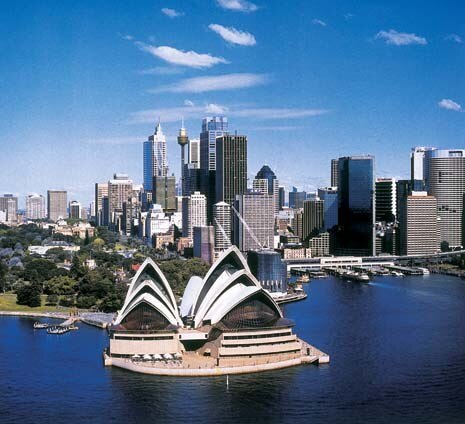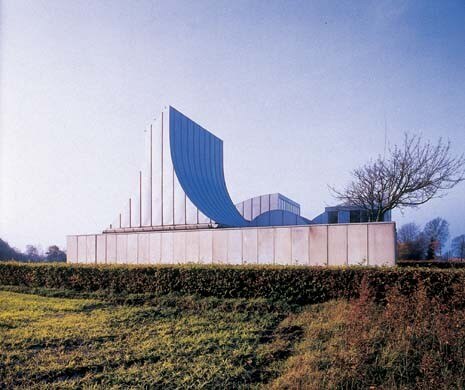Utzon
Inspiration, Vision, Architecture, by Richard Weston, Edition Bløndal, Hellerup, 2002 (pp. 435, s.i.p)
At first glance, this book by the Welsh author Richard Weston on Jorn Utzon is subject to a host of doubts. It is too big, there are too many over familiar illustrations and it is not rigorous enough in the presentation of the buildings. Moreover, the volume is uncritically nostalgic about the great architecture of the 1960s, and the biography and catalogue of the works are uncertain. It looks at a disadvantage set against the best recent books on architecture. However, the fact that it is the first monograph containing all of Utzon’s works in a single volume and that the 84-year-old Danish master edited and revised the material makes it an essential tool for comprehending one of the least understood 20th-century architects.
This book contains a variety of illustrations (sketches, building site photos, comparisons of historic buildings and natural forms), narratives of the ups and downs of design and construction (which are perhaps more revealing than the descriptions of the finished buildings) and some period documents showing how Utzon’s work was published (including a series on the Sydney Opera House published by Zodiac in the late 1950s). The discussion of the works is not exactly unified. It is a vital, uneven document, poised between a poetic manifesto and a scrapbook of materials, disseminating ideas from each page and avoiding ideological categories that have tended to be applied to the architect. These include Weston’s, for he reiterates the reading of the last great post-war builder to seek to reconcile humanism and technology by means of monumental tectonic forms inspired by the building archetypes of pre-industrial civilizations and natural forms.
This may be a good point of departure, but the outcome is never taken for granted, nor can it be reduced to a cohesive architectural language. Instead, these sources influence a working method that tries to make the structure, space, function and representation coincide, going so far as to fragment the constructions into separate tectonic units while leaving the groups ‘open’ and unpredictable. To achieve this Utzon invents highly original design processes that, because of the Danish architect’s modesty where the publication of his work is concerned, are examined for the first time in this volume. In addition to the dialectical relationship between the platform and the free roof of the Sydney Opera House (praised by Kenneth Frampton in Studies in Tectonic Culture), one also finds the process of the ‘addition’ of independent parts in the Herning School (1967-70); the variation on ‘minor’ urban fabrics formed by the courtyards in the Kingo and Fredensborg residential complexes (1957-65); the experiments with trabeation systems that culminated in the Kuwait Parliament (1969-87); and the schemes seeking a ‘poetic of the shapeless’, as in the cave-like Silkeborg Museum for the artist Asgern Jorn (1964).
The substantial difference between Utzon and the other post-war masters lies in the elusiveness of his investigations and his refusal to be enclosed in a definitive formula. The work of other leading architects could be defined by typical languages (Aalto, Scharoun, the brutalist Corbusier and Louis Kahn) or by ideological interpretations (the humanism of organicism, the participation of Team Ten or the flexibility of structuralism’s systems). In the anxiety of this ‘open’ probing and the extension of his cultural scope, Utzon comes closer to a situationist aesthetic or radical eclecticism than the ‘constructional coherence’ usually used to describe him. Therefore, his designs are far closer to those of contemporaries like Eero Saarinen or Constant than those of Aalto, Candilis, Josics, Woods or Kahn. Nothing would seem more distant from Utzon than the stylistic opportunism of the Saarinen’s Style for the Job or the incompleteness of the configurations of New Babylon. However, he shares with the former an extraordinary diversity of constructional languages (it was no accident that Saarinen was on the jury that awarded Utzon the Sydney job); with the latter he shares the opening and drifting of the developmental sections of his additive architecture (here, too, there are documented contacts between Utzon, situationism and COBRA, with Jorn as a go-between). If one removes the superficial ideological layers of 1960s modernism, one discerns an experimental Utzon who anticipated (and personally carried out) many of the latest radical trends.
From the viewpoint of the construction process as well, Utzon got involved in industrialized building more than his predecessors. Instead of controlling the whole construction, he pinpoints a repeatable tectonic idea, and then calls in industry (often with prefabricated systems) to respond and provide the details necessary to develop the system. This dialogue with engineers and producers turned out to be fundamental for the evolution of the technological innovations in Sydney (with Ove Arup) and Kuwait City (with Switzerland’s Max Walt). Of course, time has not borne out Utzon’s constructional coherence, and today’s buildings, so broken up and ‘stratified’, are a far cry from the unity of space and structure sought by the Danish architect. Yet the open process, the employment of prefabrication and the matching of the project’s phases and the evolution of technological systems controlled by flexible ‘minimum units’ could pave the way for very contemporary production potential. Utzon avoids the poetic of technology and continually allows novel spatial configurations formed by the tectonic elements themselves, revealing their compositional possibilities and figurative ambiguity. This design projection makes him an architect who is difficult to consider contextually and whose images are not easily consumed. Sydney appeared to be the icon that exhausted his aesthetic, but this volume opens further, unexpected perspectives. Hopefully Weston’s book is only the beginning; perhaps future interpretations will further develop the original foundations of designs that are too often sacrificed as examples of the universality of modernism.
Pietro Valle is an architect



